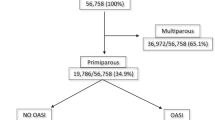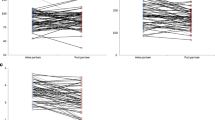Abstract
PURPOSE: Trauma to the anal sphincter is a recognized complication of primiparous childbirth. This damage may be compounded during subsequent deliveries leading to symptoms. Earlier work is inconclusive as to which delivery variables are associated with such damage and may prove useful in predicting its occurrence, thereby allowing the potential for intervention in these later deliveries to protect the traumatized anal sphincter. The purpose of the present study was to determine whether routinely recorded obstetric variables can be correlated to anal sphincter damage in a consecutive series of females. METHODS: A prospective study was undertaken in a single maternity unit. Patients delivering were assessed before discharge using a symptom questionnaire and endoanal ultrasound. Delivery data were collected prospectively and analyzed statistically to see if a significant difference existed in the presence of an anal sphincter defect. RESULTS: A total of 159 patients were assessed. Endosonography revealed sphincter injuries in 8.7 percent of the normal vaginal delivery group and 83 percent of the forceps delivery group. No correlation was found between head circumference, baby weight, maternal body mass index, epidurals, episiotomy, length of each stage of labor, and duration of active pushing. Forceps delivery was the only factor to be significantly associated with sphincter trauma. CONCLUSION: Besides forceps delivery, commonly measured delivery variables are not useful predictors of anal sphincter trauma. Normal vaginal deliveries do not warrant routine postnatal anorectal assessment. but this should be routine for all instrument deliveries.
Similar content being viewed by others

References
Snooks SJ, Henry MM, Swash M. Obstetric sphincter division and pudendal nerve damage. Br J Obstet Gynaecol 1985;92:824–8.
Thatcher SB, Banta HD. Benefits and risks of episiotomy: an interpretative review of the English literature, 1860–1980. Obstet Gynecol Surv 1983;38:322–38.
Walsh CJ, Mooney EF, Upton GJ, Motson RW. Incidence of third degree perineal tears in labour and outcome after primary repair. Br J Surg 1996;83:218–21.
Burnett SJ, Spence Jones C, Speakman CT, Kamm MA, Hudson CN, Bartram CI. Unsuspected sphincter damage following childbirth revealed by anal endosonography. Br J Radiol 1991;64:225–7.
Ryhammer AM, Bek KM, Laurberg S. Multiple vaginal deliveries increase the risk of permanent incontinence of flatus and urine in normal premenopausal women. Dis Col Rectum 1995;38:1206–9.
MacArthur C, Bick D, Keighley MR. Faecal incontinence after childbirth. Br J Obstet Gynaecol 1997;104:46–50.
Sangwan YP, Coller JA, Barrett RC,et al. Unilateral pudendal neuropathy: impact on outcome of anal sphincter repair. Dis Colon Rectum 1996;39:686–9.
Engel AF, Kamm MA, Sultan AH, Bartram CI, Nicholls RJ. Anterior anal sphincter repair in patients with obstetric trauma. Br J Surg 1994;81:1231–4.
Sultan AH, Kamm MA, Hudson CN, Bartram CI. Anal sphincter disruption during vaginal delivery. N Engl J Med 1993;329:1905–11.
Varma A, Gunn J, Duthie GS. A prospective evaluation of obstetric anal sphincter injury. Dis Colon Rectum 1997;40:A12.
Donnelly V, O'Connell PR, O'Herlihy C. The influence of hormone replacement on faecal incontinence in postmenopausal women. Br J Obstet Gynaecol 1997;104:311–5.
Haadem K, Ohrlander S, Lingman G. Long-term ailments due to anal sphincter rupture caused by delivery—a hidden problem. Eur J Obstet Gynecol Reprod Biol 1988;27:27–32.
Crawford LA, Quint EH, Pearl ML, DeLancey JO. Incontinence following rupture of the anal sphincter during delivery. Obstet Gynecol 1993;82:527–31.
Nikiteas N, Korgsen S, Kumar D, Keighley MR. Audit of sphincter repair: factors associated with poor outcome. Dis Colon Rectum 1996;39:1164–70.
Author information
Authors and Affiliations
Additional information
Supported by the British Medical Association (Katherine Bishop Harman Award, 1996).
Read at the meeting of The American Society of Colon and Rectal Surgeons, San Antonio, Texas, May 2 to 7, 1998.
About this article
Cite this article
Varma, A., Gunn, J., Lindow, S.W. et al. Do routinely measured delivery variables predict anal sphincter outcome?. Dis Colon Rectum 42, 1261–1264 (1999). https://doi.org/10.1007/BF02234210
Issue Date:
DOI: https://doi.org/10.1007/BF02234210



